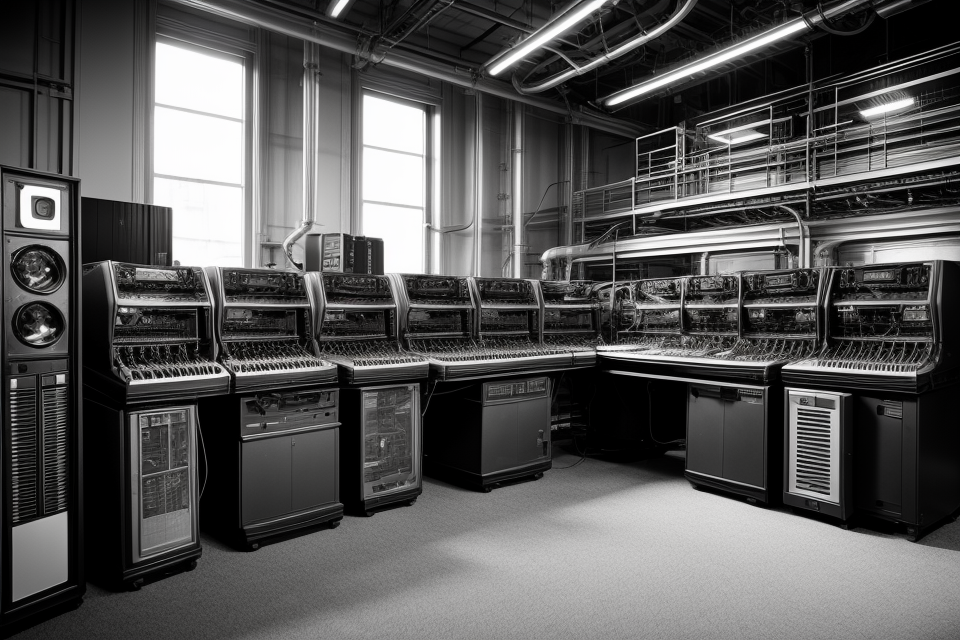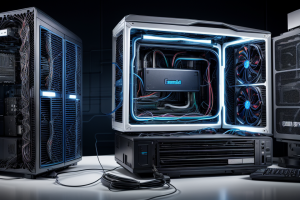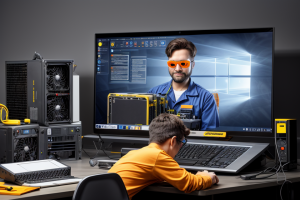
The history of computer cooling solutions is a fascinating journey through the ages, from the early days of computing to the modern age of advanced technology. The first computers were massive machines that required innovative cooling solutions to prevent overheating and malfunctioning. In this article, we will explore the different methods used to cool the earliest computers, including air conditioning, liquid cooling, and heat sinks. We will also discuss how these cooling solutions evolved over time, allowing computers to become smaller, faster, and more efficient. So, let’s dive in and discover the exciting world of computer cooling!
The first computers were cooled using mechanical fans and air circulation systems. As the technology advanced, water cooling systems were introduced, which were more efficient and effective in removing heat from the computer components. The development of thermoelectric cooling technology in the 1950s provided a new solution for cooling computers, and this technology is still used today in many high-performance computers. The advent of liquid cooling systems in the 1990s brought about a significant improvement in heat dissipation and efficiency, and this technology is now widely used in modern computers.
The Evolution of Computer Cooling
The Early Days: Air-Cooled Computers
Passive Cooling Systems
In the early days of computing, passive cooling systems were used to keep the machines running smoothly. These systems relied on natural convection and heat dissipation to cool the components.
One common passive cooling system was the use of large fans that blew air over the computer’s heat-generating components. This method was effective in some cases, but it was limited by the size and weight of the fans, which could be noisy and power-hungry.
Another passive cooling method was the use of heat sinks, which are metal or plastic containers that are placed in contact with the heat-generating components. The heat sinks contain fins or other surface enhancements that increase the surface area of the container, allowing it to dissipate heat more effectively.
Active Cooling Systems
As computers became more powerful and smaller, it became clear that passive cooling systems were not sufficient to keep them running at optimal temperatures. Active cooling systems were developed to provide more efficient cooling solutions.
One common active cooling system is liquid cooling, which uses a liquid coolant to transfer heat away from the heat-generating components. The liquid coolant is pumped through a system of tubes and radiators, which dissipate the heat into the surrounding air.
Another active cooling method is the use of refrigeration units, which use compressed gases to cool the liquid coolant. This method is particularly effective in data centers, where large numbers of computers are housed in close proximity.
In summary, the early days of computer cooling were characterized by the use of passive cooling systems, such as fans and heat sinks. As computers became more powerful and smaller, active cooling systems, such as liquid cooling and refrigeration, were developed to provide more efficient cooling solutions.
The Rise of Liquid Cooling
Water-Based Cooling Systems
The first computers used air as the primary cooling medium, relying on natural convection and heat dissipation to maintain temperatures within safe limits. However, as computing power increased, so did the amount of heat generated by the components. This led to the development of water-based cooling systems that could more effectively remove heat from the system.
One of the earliest water-based cooling systems was the flood-based cooling system, which used water to directly cool the components. In this system, water was pumped through the computer’s components, carrying away the heat generated by the CPU, memory, and other components. The water was then circulated through a radiator, where it was cooled before being recirculated back into the system.
Flood-based cooling systems were effective, but they had several drawbacks. They were prone to leaks, which could cause serious damage to the components if not detected and repaired quickly. They also required a significant amount of water, which could be difficult to manage in some environments.
To address these issues, the next generation of water-based cooling systems was developed: the cold plate. In a cold plate system, a thin metal plate was placed in contact with each component that needed to be cooled. The plate was connected to a network of pipes that carried water through the system. As the water flowed through the plates, it absorbed the heat generated by the components and carried it away to a radiator, where it was cooled before being recirculated back into the system.
Cold plate systems were more reliable than flood-based systems, as they were less prone to leaks and could be easily serviced. They also used less water, making them more environmentally friendly. However, they still had some drawbacks. The metal plates could corrode over time, which could cause problems with the cooling system. They also required a significant amount of maintenance, as the plates needed to be cleaned regularly to prevent buildup of debris.
Liquid-to-Liquid Cooling Systems
As computing power continued to increase, the limitations of water-based cooling systems became more apparent. Water is a relatively inefficient cooling medium, as it has a high thermal resistance and is prone to boiling at high temperatures. This can limit the amount of heat that can be removed from the system.
To address these issues, liquid-to-liquid cooling systems were developed. In a liquid-to-liquid system, a coolant is used to absorb the heat generated by the components. The coolant is then pumped through a secondary loop, where it is cooled by a radiator before being recirculated back into the system.
Liquid-to-liquid cooling systems offer several advantages over water-based systems. They can use coolants with lower thermal resistance, which allows them to remove more heat from the system. They are also less prone to boiling, which means they can operate at higher temperatures without causing damage to the components. Additionally, they can be more easily customized to meet the specific cooling needs of different components.
However, liquid-to-liquid cooling systems also have some drawbacks. They can be more complex to set up and maintain than water-based systems, as they require two separate loops for the coolant and the secondary cooling fluid. They can also be more expensive, as they require specialized components and coolants.
Overall, the evolution of computer cooling solutions has been driven by the need to remove ever-increasing amounts of heat generated by computing components. From air-based cooling to water-based cooling and finally to liquid-to-liquid cooling, each new technology has brought its own advantages and challenges. Today’s high-performance computing systems rely on sophisticated cooling solutions to maintain safe operating temperatures, ensuring that they can continue to operate at peak performance.
The Modern Era: Advanced Cooling Solutions
High-Performance Liquid Cooling
High-performance liquid cooling (HPLC) is a cutting-edge cooling solution that has become increasingly popular in recent years. It uses liquid to remove heat from the computer’s critical components, offering several advantages over traditional air cooling.
Cooling for Gaming Computers
In the world of gaming, HPLC is used to cool high-performance gaming computers, known as gaming rigs or gaming PCs. These computers require efficient cooling solutions to maintain optimal performance while running resource-intensive games. HPLC offers several benefits for gaming computers, including:
- Reduced noise levels: Unlike air cooling, HPLC systems are much quieter, making them ideal for gaming setups where noise levels need to be kept to a minimum.
- Increased thermal conductivity: Liquid is a better conductor of heat than air, which means that HPLC systems can dissipate heat more efficiently and effectively.
- Customizable: HPLC systems can be customized to fit the specific needs of gaming computers, providing optimal cooling for each individual setup.
Cooling for Data Centers
Data centers are large facilities that house hundreds or even thousands of servers. These servers generate a significant amount of heat, which can be detrimental to the overall performance and reliability of the data center. HPLC offers several benefits for data center cooling, including:
- Improved energy efficiency: HPLC systems can be more energy-efficient than traditional air cooling systems, which can help reduce the overall energy consumption of the data center.
- Reduced maintenance costs: HPLC systems have fewer moving parts than air cooling systems, which means they require less maintenance and can last longer.
- Better heat dissipation: HPLC systems can remove heat from servers more efficiently than air cooling systems, which can help prevent overheating and improve the overall reliability of the data center.
Overall, HPLC has become a popular choice for cooling both gaming computers and data centers due to its efficiency, customizability, and quiet operation. As technology continues to advance, it is likely that HPLC will become an even more integral part of modern computing.
Thermal Management for High-Performance Computing
Thermal Interface Materials
Thermal interface materials (TIMs) are critical components in high-performance computing systems, as they play a crucial role in transferring heat from the source to the sink. TIMs are typically made of materials such as thermal grease, thermal pads, or thermal tapes, which are placed between the heat-generating components and the heat sink to improve thermal conductivity.
The choice of TIM depends on the specific application and the type of heat sink used. For example, thermal grease is often used for applications that require a fast and uniform heat transfer, while thermal pads are suitable for applications that require a higher thermal conductivity and can tolerate non-uniform heat distribution. Thermal tapes are commonly used in applications where the components are difficult to access or when a temporary solution is required.
TIMs have become increasingly important in modern computing systems due to the growing demand for higher performance and power density. As processors and other components generate more heat, TIMs are used to ensure efficient heat transfer and prevent thermal-induced failures.
Phase Change Materials
Phase change materials (PCMs) are another type of TIMs that have gained popularity in recent years due to their ability to store and release large amounts of thermal energy. PCMs are typically made of materials such as waxes, salts, or metal alloys that change phase (e.g., solid to liquid) in response to changes in temperature.
PCMs are particularly useful in applications where the heat load is variable or difficult to predict, such as in data centers or cloud computing environments. By storing and releasing thermal energy as needed, PCMs can help to smooth out temperature fluctuations and improve overall system efficiency.
One of the main advantages of PCMs is their high thermal storage capacity, which allows them to absorb and release large amounts of heat without significant changes in temperature. This can help to reduce the overall thermal stress on the system and improve its reliability and longevity.
PCMs can be incorporated into various components of the computing system, such as heat sinks, thermal interface materials, or even integrated into the CPU itself. This allows for greater flexibility in thermal management and can help to optimize the overall performance and efficiency of the system.
In summary, thermal management is a critical aspect of high-performance computing, and the use of advanced cooling solutions such as TIMs and PCMs is essential for ensuring reliable and efficient operation of modern computing systems. By understanding the specific needs and requirements of different applications, designers and engineers can select the most appropriate cooling solutions to meet the demands of today’s complex computing environments.
Energy-Efficient Cooling Solutions
In the modern era of computing, energy efficiency has become a significant concern. With the increasing demand for computing power and the need to reduce energy consumption, advanced cooling solutions have been developed to improve the energy efficiency of computers.
Server Liquid Cooling
Server liquid cooling is a method of cooling that uses liquid instead of air to remove heat from the server. In this method, a liquid coolant is pumped through a copper tube that is in contact with the heat-generating components of the server. The liquid coolant absorbs the heat and carries it away to a heat exchanger, where it is dissipated into the atmosphere. This method is highly efficient and can reduce the energy consumption of servers by up to 90%.
Immersion Cooling
Immersion cooling is another advanced cooling solution that involves submerging the computer components in a liquid coolant. In this method, the entire computer system is immersed in a coolant, and the heat generated by the components is dissipated into the liquid. The liquid coolant is then pumped through a heat exchanger, where the heat is dissipated into the atmosphere. This method is highly efficient and can reduce the energy consumption of computers by up to 95%.
Overall, these energy-efficient cooling solutions have significantly improved the energy efficiency of computers, while still providing the necessary cooling to prevent overheating.
FAQs
1. What were the first computers made of?
The first computers were made of various materials, including vacuum tubes, transistors, and diodes. These components generated a lot of heat, which had to be dissipated to prevent the computer from overheating and malfunctioning.
2. How did early computers dissipate heat?
Early computers relied on passive cooling methods, such as natural convection and air circulation. The computer room was usually located near a window to allow for cross ventilation, and large fans were used to circulate air around the computer. Some computers also used heat sinks, which helped to dissipate heat away from the components.
3. When did active cooling methods become popular?
Active cooling methods, such as liquid cooling and fan-based cooling, became popular in the 1960s and 1970s as computers became more powerful and smaller in size. Liquid cooling systems used a liquid coolant to absorb heat from the components and transfer it to a radiator, where it could be dissipated. Fan-based cooling systems used electric fans to force air over the components and dissipate heat.
4. What are some modern cooling solutions for computers?
Modern computers use a variety of cooling solutions, including liquid cooling, fan-based cooling, and heat pipes. Liquid cooling systems are still used in high-performance computers, such as gaming PCs and servers. Fan-based cooling systems are used in most desktop and laptop computers. Heat pipes are also used in some computers to dissipate heat away from the components. Additionally, some computers use thermoelectric cooling, which uses the Peltier effect to create a temperature gradient and dissipate heat.







